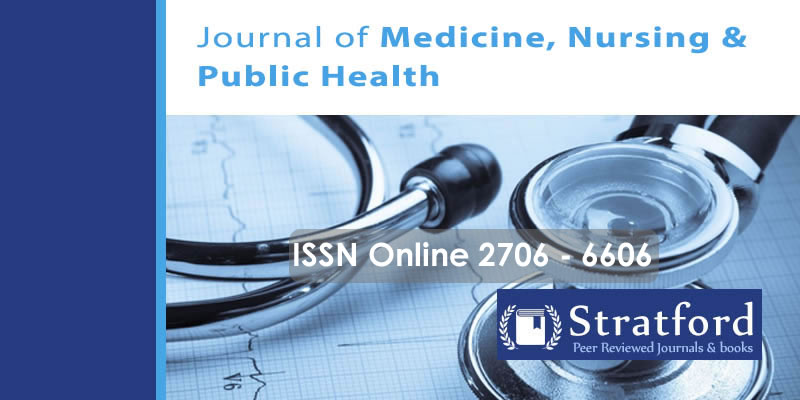Prevalence and Factors Associated with Postpartum Infections among Mothers Attending Immunization Service at Health Centers of Nyanza District, Rwanda
DOI:
https://doi.org/10.53819/81018102t5162Abstract
Postpartum infections are life-threatening conditions leading to 10% of maternal deaths worldwide; in sub-Saharan Africa, the estimated prevalence of postpartum infections is 11.5%. In Rwanda maternal sepsis contribute up to 56% of all maternal complications, where 5% of them die and most cases come from rural areas. In line with the above-mentioned background, this research aimed to find out the prevalence and factors contributing to postpartum infections in Nyanza District/ Rwanda. This study employed a cross-sectional design, with participants being mothers attending immunization services at health centers in Nyanza district. A sample size of 384 was determined for all health centers, with systematic sampling used to select individual participants. Data collection involved a structured questionnaire and a review of medical records. A case of postpartum infection was identified if self-reported signs or symptoms were also documented in the participant's medical records. Data analysis was conducted using IBM® SPSS 21. Descriptive statistics were utilized, and a bivariate analysis was performed to identify independent variables associated with postpartum infections. Variables significantly associated with the outcome were further analyzed using a multivariate logistic regression model. As results, the prevalence of postpartum infection among mothers attending immunization service at health centers of Nyanza District was 9.6%; and the identified factors associated with postpartum infections were delivering by caesarean (aOR=6, 95%CI: 5.082-8.229, P<0.001); frequent vaginal examinations (≥5 times) during labor (aOR= 2.7, 95% CI: 1.331-5.843, P<0.001); prolonged labor (>24 hours) (aOR=2.0, 95% CI: 1.205-6.010, P<0.001); and Farming occupation (aOR=1.9, 95% CI: 1.120-4.966, P=0.048). Hence, the study recommends that healthcare professionals should aim to minimize C-section deliveries and the frequency of vaginal examinations when possible. Prophylactic antibiotics and aseptic techniques should be employed during delivery, especially for mothers with prolonged labor, frequent examinations, C-section deliveries, and farming occupations. Policymakers should develop guidelines to reduce cesarean sections, discourage frequent vaginal examinations, and promote prophylactic antibiotic use for high-risk mothers. Healthcare workers should prioritize infection prevention practices for mothers undergoing C-sections. Additionally, efforts should focus on reducing labor duration and ensuring timely interventions to prevent complications leading to postpartum infections. High-risk groups should be targeted for health education programs promoting hygiene practices and preventing exposure to microbial reservoirs. Further research is needed countrywide to determine the real burden of postpartum infections and identify measures to mitigate these life-threatening infections.
Keywords: Postpartum infections, mothers, immunization service, Health Centers, Nyanza District, Rwanda
References
2. Axelsson, D. (2019). Postpartum infections; prevalence, associated obstetric factors and the role of vitamin D (Issue 1686). https://books.google.com.eg/books?id=bp6cDwAAQBAJ
3. Hallett, C. (2005). The attempt to understand puerperal fever in the eighteenth and early nineteenth centuries: The influence of inflammation theory. Medical History, 49(1), 1–28. https://doi.org/10.1017/S0025727300000119
4. Kajeguka, D. C., Reuben, N., Mawazo, A., & Malya, R. (2020). Factors and Causes of Puerperal Sepsis in Kilimanjaro , Tanzania : A Descriptive Study among Postnatal Women who Attended Kilimanjaro Christian Medical Centre. 4(2), 2–7.
5. Milani, H. S., Amiri, P., Mohsey, M., Monfared, E. D., Vaziri, S. M., Malekkhahi, A., & Salmani, F. (2017). Effect of health care as the “home visiting” on postpartum depression: A controlled clinical trial. International Journal of Preventive Medicine, 8, 1–6. https://doi.org/10.4103/2008-7802.204003
6. Musarandega, R., Nyakura, M., Machekano, R., Pattinson, R., & Munjanja, S. P. (2021). Causes of maternal mortality in Sub-Saharan Africa: A systematic review of studies published from 2015 to 2020. Journal of Global Health, 11, 04048. https://doi.org/10.7189/jogh.11.04048
7. Ngonzi, J., Bebell, L. M., Fajardo, Y., Boatin, A. A., Siedner, M. J., Bassett, I. V., Jacquemyn, Y., Van geertruyden, J. P., Kabakyenga, J., Wylie, B. J., Bangsberg, D. R., & Riley, L. E. (2018). Incidence of postpartum infection, outcomes and associated risk factors at Mbarara regional referral hospital in Uganda. BMC Pregnancy and Childbirth, 18(1), 1–11. https://doi.org/10.1186/s12884-018-1891-1
8. Nkurunziza, T., Kateera, F., Sonderman, K., Gruendl, M., Nihiwacu, E., Ramadhan, B., Cherian, T., Nahimana, E., Ntakiyiruta, G., Habiyakare, C., Ngamije, P., Matousek, A., Gaju, E., Riviello, R., & Hedt-Gauthier, B. (2019). Prevalence and predictors of surgical-site infection after caesarean section at a rural district hospital in Rwanda. British Journal of Surgery, 106(2), e121–e128. https://doi.org/10.1002/bjs.11060
9. Oakley, L. (2018). The prevalence and risk factors of puerperal sepsis in South Asia. LONDON SCHOOL of HYGINE & TROPICAL MEDICINE, September.
10. Rwabizi, D., Rulisa, S., Aidan, F., & Small, M. (2016). Maternal near miss and mortality due to postpartum infection: A cross-sectional analysis from Rwanda. BMC Pregnancy and Childbirth, 16(1), 1–5. https://doi.org/10.1186/s12884-016-0951-7
11. Talie, A., Yekoye, A., Alemu, M., Temesgen, B., & Aschale, Y. (2018). Magnitude and associated factors of postpartum morbidity in public health institutions of Debre Markos town , North. 1–7.
12. Tuyishime, E., Mvukiyehe, J. P., Cubaka, V. K., & Banguti, P. R. (2020). Post-delivery complications and quality of birth practice in district hospitals in Rwanda: A cross-sectional study. Rwanda Medical Journal, 77(3), 9–15.
13. World Health Organization. (2015). WHO recommendations for prevention and treatment of maternal peripartum infections. World Health Organization, 80.


